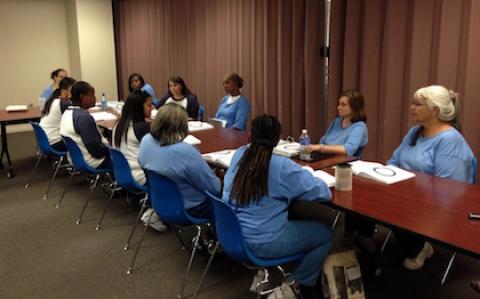The United States contains 5% of the world’s women and 33% of its incarcerated women, more per capita, and in absolute terms, than any other country in the world. Though that’s only 7% of the US prisoner population overall, the statistics don’t reflect the uniquely horrible circumstances many incarcerated women faced before their convictions.
They’re girls who were victimized as children, ignored in substandard schools and unprotected by social services. Girls who dropped out of high school, self-medicated with alcohol or illegal drugs and then made mistakes that got them caught up the in the prison industrial complex.
The reality of these women’s struggles was driven home anew in a report, released Wednesday by the Vera Institute of Justice and the Safety and Justice Challenge. It says that women are the fastest-growing demographic in our jails – where people are booked and held prior to conviction – and that this is exacerbating the societal disadvantages they face.
The US does a disservice to its female prisoner population by locking them up without giving them a first chance in life, much less a second one.
A shocking 32% of the women incarcerated in New York were victims of rape before arrest. In the New York prison where I teach as a volunteer in Columbia University’s Justice-in-Education Initiative, 82% of the women experienced severe physical or sexual abuse as children, and 75% suffered physical violence by an intimate partner during adulthood.
Although roughly 18% of New York residents are black, a 2013 department of corrections study showed that black women constitute 42.6% of the women incarcerated, many of whom come from economically depressed neighborhoods with inadequate schools and little support for troubled and abused girls. Of the eight women I taught in Columbia’s program this summer, seven were black. When arrested, 43% of women in New York prisons did not have a high school diploma and over half had a substance abuse problem.
I’ve come to know some of these women well. We’re not supposed to talk about personal matters in class, but you can’t teach literature and philosophy in prison without learning about past trauma, current fears and what landed people behind bars.
My students are unblinkingly realistic about the mistakes they made as teenagers and the terrible things done to them as girls. I hear echoes of the abuse they suffered when they discuss the fate of Cassandra and Iphigenia in Aeschylus’ Oresteia, the mean-spirited prank played on Malvolio in Shakespeare’s Twelfth Night, or the purity of Socrates’ soul as he calmly drinks hemlock in his prison cell.
Almost two millennia ago, Clement of Alexandria summarized the view of many of his contemporaries: “To act is the mark of man; to suffer the mark of the woman.” It would take hundreds of years of struggle before women were considered fit to be active members of society and unfit to be treated as natural born victims. When the former slave Sojourner Truth stood up to hisses and hollers in 1853 and argued for the rights of women – and black ones at that – she acknowledged: “We have all been thrown down so low that nobody thought we’d ever get up again.”
This has persisted, but my students are getting up and creating their own first chances. Despite the razor wire, steel walls and constant fear of abuse and solitary confinement, they have learned to focus on schoolwork, doing well enough to get into Columbia’s program. Despite having to write papers in longhand and take exams in stifling classrooms, they delight in understanding profound ideas, constantly giving me – the so-called expert – new insights about the philosophical and literary subtleties of books I’ve taught for years.
These women deserve a second chance. Barack Obama has emphasized the importance of clemency for prisoners, granting more commutations and pardons than the previous nine presidents combined and more than any individual president in nearly a century. Tragically, my students aren’t eligible for his pardon since they are state prisoners. And because the New York parole board has a bad record of seeing redemption in even the best-behaved prisoners, my students have a higher wall to scale from their low-down place.
But if our president and others who have never lacked for opportunity began to talk about these women, the abuse they suffered as girls, and to encourage parole boards to give them clemency, then we might just start to see a transformative kind of freedom. Clemency-granting boards and governors might give second chances to women who never had a first one.
[Christia Mercer is the Gustave M Berne Professor of Philosophy at Columbia University. She teaches philosophy and literature at Taconic Correctional Facilities as part of Columbia’s Justice-in-Education Initiative.]
[To download the fact sheet and the complete study: Overlooked: Women and Jails in an Era of Reform, go to the Vera Institute of Justice and the Safety and Justice Challenge.]


Spread the word